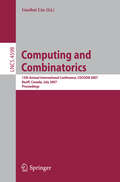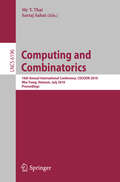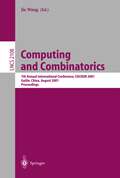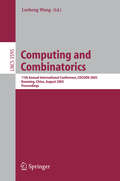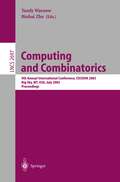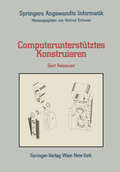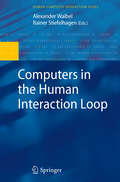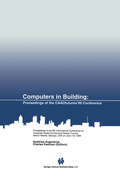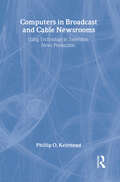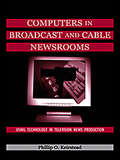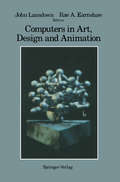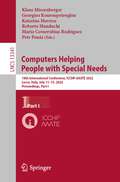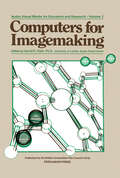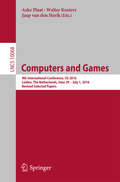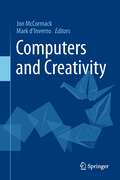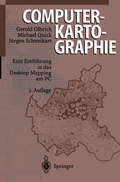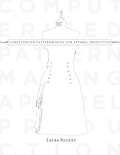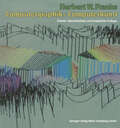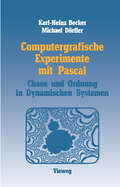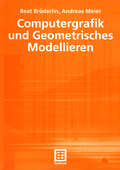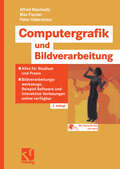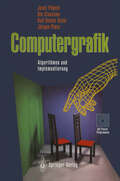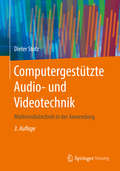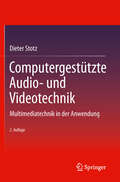- Table View
- List View
Computing and Combinatorics: 13th Annual International Conference, COCOON 2007, Banff, Canada, July 16-19, 2007, Proceedings (Lecture Notes in Computer Science #4598)
by Guohui LinThe Annual International Computing and Combinatorics Conference is an annual forum for exploring research, development, and novel applications of computing and combinatorics. It brings together researchers, professionals and industrial practitioners to interact and exchange knowledge, ideas and progress. Thetopics covermost aspects oftheoreticalcomputer scienceand combinatorics related to computing. The 13th Annual International Computing and Com- natorics Conference (COCOON 2007) was held in Ban?, Alberta during July 16–19, 2007. This was the ?rst time that COCOON was held in Canada. We received 165 submissions, among which 11 were withdrawn for various reasons. The remaining 154 submissions under full consideration came from 33 countries and regions: Australia, Brazil, Canada, China, the Czech Republic, Denmark, Finland, France, Germany, Greece, Hong Kong, India, Iran, Ireland, Israel, Italy, Japan, the Netherlands, Norway, Pakistan, Poland, Romania, R- sia, Slovakia, South Korea, Spain, Sweden, Switzerland, Taiwan, Turkey, the UK, the USA, and the US minor outlying islands. Afterasixweekperiodofcarefulreviewinganddiscussions,theprogramc- mittee accepted 51 submissions for oral presentation at the conference. Based on the a?liations, 1. 08 of the accepted papers were from Australia, 7. 67 from Canada, 3. 08 from China, 1 from the Czech Republic, 2 from Denmark, 1 from France, 5. 42 from Germany, 0. 08 from Greece, 2. 18 from Hong Kong, 0. 33 from India, 0. 17 from Ireland, 1. 83 from Israel, 1. 5fromItaly,2. 9 from Japan, 0. 17 from the Netherlands, 2. 67 from Norway, 0.
Computing and Combinatorics: 16th Annual International Conference, COCOON 2010, Nha Trang, Vietnam, July 19-21, 2010 Proceedings (Lecture Notes in Computer Science #6196)
by My T. Thai Sartaj SahniComputing and Combinatorics: 7th Annual International Conference, COCOON 2001, Guilin, China, August 20-23, 2001, Proceedings (Lecture Notes in Computer Science #2108)
by Jie WangComputing and Combinatorics: 11th Annual International Conference, COCOON 2005, Kunming, China, August 16-19, 2005, Proceedings (Lecture Notes in Computer Science #3595)
by Lusheng WangComputing and Combinatorics: 9th Annual International Conference, COCOON 2003, Big Sky, MT, USA, July 25-28, 2003, Proceedings (Lecture Notes in Computer Science #2697)
by Tandy Warnow Binhai ZhuThe refereed proceedings of the 9th Annual International Computing and Combinatorics Conference, COCOON 2003, held in Big Sky, MT, USA in July 2003. The 52 revised full papers presented together with 3 invited contributions were carefully reviewed and selected from 114 submissions. The papers are organized in topical sections on computational geometry, computational biology, computability and complexity theory, graph theory and graph algorithms, automata and Petri net theory, distributed computing, Web-based computing, scheduling, graph drawing, and fixed-parameter complexity theory.
Computers in the Human Interaction Loop (Human–Computer Interaction Series)
by Alexander Waibel Rainer StiefelhagenThis book integrates a wide range of research topics related to and necessary for the development of proactive, smart, computers in the human interaction loop, including the development of audio-visual perceptual components for such environments; the design, implementation and analysis of novel proactive perceptive services supporting humans; the development of software architectures, ontologies and tools necessary for building such environments and services, as well as approaches for the evaluation of such technologies and services. The book is based on a major European Integrated Project, CHLI (Computers in the Human Interaction Loop), and throws light on the paradigm shift in the area of HCI that rather than humans interactive directly with machines, computers should observe and understand human interaction, and support humans during their work and interaction in an implicit and proactive manner.
Computers in Building: Proceedings of the CAADfutures’99 Conference. Proceedings of the Eighth International Conference on Computer Aided Architectural Design Futures held at Georgia Institute of Technology, Atlanta, Georgia, USA on June 7–8, 1999
by Godfried Augenbroe Charles EastmanSince the establishment of the CAAD Futures Foundation in 1985, CAAD experts from all over the world meet every two years to present and document the state of the art of research in Computer Aided Architectural Design. Together, the series provides a good record of the evolving state of research in this area over the last fourteen years. The Proceedings this year is the eighth in the series. The conference held at Georgia Institute of Technology in Atlanta, Georgia, includes twenty-five papers presenting new and exciting results and capabilities in areas such as computer graphics, building modeling, digital sketching and drawing systems, Web-based collaboration and information exchange. An overall reading shows that computers in architecture is still a young field, with many exciting results emerging out of both greater understanding of the human processes and information processing needed to support design and also the continuously expanding capabilities of digital technology.
Computers in Broadcast and Cable Newsrooms: Using Technology in Television News Production
by Phillip O. KeirsteadComputers in Broadcast and Cable Newsrooms: Using Technology in Television News Production takes readers through the use of computers and software in the broadcast/cable newsroom environment. Author Phillip O. Keirstead began writing about television news technology decades ago in an effort to help television news managers cope with technological change. In this text, he demonstrates the myriad ways in which today's journalism is tied to technology, and he shows how television news journalists rely on varied and complex technologies to produce timely, interesting, and informative broadcasts. Using a hands-on, practical approach to cover the role computers play in various parts of the newsroom, the volume will be of great practical value to undergraduate and graduate students in advanced broadcast/news television courses.
Computers in Broadcast and Cable Newsrooms: Using Technology in Television News Production
by Phillip O. KeirsteadComputers in Broadcast and Cable Newsrooms: Using Technology in Television News Production takes readers through the use of computers and software in the broadcast/cable newsroom environment. Author Phillip O. Keirstead began writing about television news technology decades ago in an effort to help television news managers cope with technological change. In this text, he demonstrates the myriad ways in which today's journalism is tied to technology, and he shows how television news journalists rely on varied and complex technologies to produce timely, interesting, and informative broadcasts. Using a hands-on, practical approach to cover the role computers play in various parts of the newsroom, the volume will be of great practical value to undergraduate and graduate students in advanced broadcast/news television courses.
Computers in Art, Design and Animation
by John Lansdown Rae EarnshawThe collection of papers that makes up this book arises largely from the joint activities of two specialist groups of the British Computer Society, namely the Displays Group and the Computer Arts Society. Both these groups are now more than 20 years old and during the whole of this time have held regular, separate meetings. In recent years, however, the two groups have held a joint annual meeting at which presentations of mutual interest have been given and it is mainly from the last two of these that the present papers have been drawn. They fall naturally into four classes: visualisation, art, design and animation-although, as in all such cases, the boundaries between the classes are fuzzy and overlap inevitably occurs. Visualisation The graphic potential of computers has been recognised almost since computing was first used, but it is only comparatively recently that their possibilities as devices for the visualisation of complex. and largely ab stract phenomena has begun to be more fully appreciated. Some workers stress the need to be able to model photographic reality in order to assist in this task. They look to better algorithms and more resolution to achieve this end. Others-Alan Mackay for instance-suggest that it is "not just a matter of providing more and more pixels. It is a matter of providing congenial clues which employ to the greatest extent what we already know.
Computers Helping People with Special Needs: 18th International Conference, ICCHP-AAATE 2022, Lecco, Italy, July 11–15, 2022, Proceedings, Part I (Lecture Notes in Computer Science #13341)
by Klaus Miesenberger Georgios Kouroupetroglou Katerina Mavrou Roberto Manduchi Mario Covarrubias Rodriguez Petr PenázThe two-volume set LNCS 13341 and 13342 constitutes the refereed proceedings of the Joint International Conference on Digital Inclusion, Assistive Technology, and Accessibility, ICCHP-AAATE 2022. The conference was held in Lecco, Italy, in July 2022.The 112 papers presented were carefully reviewed and selected from 285 submissions. Included also are 18 introductions. The papers are organized in the following topical sections: Part I: Art Karshmer Lectures in Access to Mathematics, Science and Engineering; Digital Solutions for Inclusive Mobility: solutions and accessible maps for indoor and outdoor mobility; implementation and innovation in the area of independent mobility through digital technologies; haptic and digital access to art and artefacts; accessibility of co-located meetings; interactions for text input and alternative pointing; cognitive disabilities and accessibility; augmentative and alternative communication (AAC): emerging trends, opportunities and innovations; language accessibility for the deaf and hard-of-hearing. Part II: Digital accessibility: readability and understandability; serious and fun games; internet of things: services and applications for people with disabilities and elderly persons; technologies for inclusion and participation at work and everyday activities; robotic and virtual reality technologies for children with disabilities and older adults; development, evaluation and assessment of assistive technologies; ICT to support inclusive education – universal learning design (ULD); design for assistive technologies and rehabilitation; assistive technologies and inclusion for older people.
Computers for Imagemaking
by D. ClarkComputers for Image-Making tells the computer non-expert all he needs to know about Computer Animation. In the hands of expert computer engineers, computer picture-drawing systems have, since the earliest days of computing, produced interesting and useful images. As a result of major technological developments since then, it no longer requires the expert's skill to draw pictures; anyone can do it, provided they know how to use the appropriate machinery. This collection of specially commissioned articles reflects the diversity of user applications in this expanding field
Computers and Games: 9th International Conference, CG 2016, Leiden, The Netherlands, June 29 – July 1, 2016, Revised Selected Papers (Lecture Notes in Computer Science #10068)
by Aske Plaat Walter Kosters Jaap HerikThis book constitutes the thoroughly refereed post-conference proceedings of the 9th International Conference on Computers and Games, CG 2016, held in Leiden, The Netherlands,in conjunction with the 19th Computer Olympiad and the 22nd World Computer-Chess Championship.The 20 papers presented were carefully reviewed and selected of 30 submitted papers. The 20 papers cover a wide range of computer games and many different research topics in four main classes which determined the order of publication: Monte Carlo Tree Search (MCTS) and its enhancements (seven papers), concrete games (seven papers), theoretical aspects and complexity (five papers) and cognition model (one paper). The paper Using Partial Tablebases in Breakthrough by Andrew Isaac and Richard Lorentz received the Best Paper Award.
Computers and Creativity
by Jon McCormack and Mark d’InvernoThis interdisciplinary volume introduces new theories and ideas on creativity from the perspectives of science and art. Featuring contributions from leading researchers, theorists and artists working in artificial intelligence, generative art, creative computing, music composition, and cybernetics, the book examines the relationship between computation and creativity from both analytic and practical perspectives. Each contributor describes innovative new ways creativity can be understood through, and inspired by, computers.The book tackles critical philosophical questions and discusses the major issues raised by computational creativity, including: whether a computer can exhibit creativity independently of its creator; what kinds of creativity are possible in light of our knowledge from computational simulation, artificial intelligence, evolutionary theory and information theory; and whether we can begin to automate the evaluation of aesthetics and creativity in silico. These important, often controversial questions are contextualised by current thinking in computational creative arts practice. Leading artistic practitioners discuss their approaches to working creatively with computational systems in a diverse array of media, including music, sound art, visual art, and interactivity.The volume also includes a comprehensive review of computational aesthetic evaluation and judgement research, alongside discussion and insights from pioneering artists working with computation as a creative medium over the last fifty years. A distinguishing feature of this volume is that it explains and grounds new theoretical ideas on creativity through practical applications and creative practice.Computers and Creativity will appeal to theorists, researchers in artificial intelligence, generative and evolutionary computing, practicing artists and musicians, students and any reader generally interested in understanding how computers can impact upon creativity. It bridges concepts from computer science, psychology, neuroscience, visual art, music and philosophy in an accessible way, illustrating how computers are fundamentally changing what we can imagine and create, and how we might shape the creativity of the future.Computers and Creativity will appeal to theorists, researchers in artificial intelligence, generative and evolutionary computing, practicing artists and musicians, students and any reader generally interested in understanding how computers can impact upon creativity. It bridges concepts from computer science, psychology, neuroscience, visual art, music and philosophy in an accessible way, illustrating how computers are fundamentally changing what we can imagine and create, and how we might shape the creativity of the future.
Computerkartographie: Eine Einführung in das Desktop Mapping am PC
by Gerold Olbrich Michael Quick Jürgen SchweikartDie Darstellung raumbezogener Daten in Kartenform hat dank der rasanten Entwicklung entsprechender Software stark zugenommen. Immer häufiger bedienen sich heute auch Praktiker und Wissenschaftler, die im Zuge ihrer Ausbildung keine Erfahrung auf dem Gebiet der thematischen Kartographie sammeln konnten, dieser Form der Visualisierung. Ziel dieses Titels ist es daher, dem Leser zunächst unverzichtbares Basiswissen aus dem Bereich der thematischen Kartographie zu vermitteln, um darauf aufbauend die Methodik der angewandten Computerkartographie zu erläutern. Darüber hinaus wird ein Überblick über die Leistungsmerkmale gängiger Software gegeben. Die beiliegende CD-ROM enthält Demoversionen zu den verschiedenen Programmen. Ein Quellenverzeichnis im Anhang führt Bezugsadressen für Koordinatendaten und Software auf.
Computerized Patternmaking for Apparel Production
by Laura NugentComputerized Patternmaking for Apparel Production takes a unique approach to learning Gerber AccuMark technology. This book includes all the procedures that the fashion industry uses to create a style and rush it to a factory for cutting and mass production. Through 20 lessons focusing on patternmaking, digitizing, grading, and marker making, students will grasp the cycle of apparel production from patternmaking to cutting. This book bridges the gap between knowing what the software functions do and applying them in today's working environment.
Computergrafische Experimente mit Pascal: Ordnung und Chaos in Dynamischen Systemen
by Karl-Heinz Becker Michael DörflerComputergrafik - Zur Geschichte und Produktionsästhetik synthetischer Bilder (Image #230)
by Carolin SchelerEs existieren zahlreiche Verfahren, um digitale Bilder zu erzeugen. Diese Vielfalt erschwert es allerdings, digitale Fotografien, KI- oder CGI-Bilder voneinander zu differenzieren. Carolin Scheler legt am Beispiel der 3D-Computergrafik einen grundlegend neuen Ansatz vor, digitale Bilderzeugnisse ästhetisch zu analysieren. Ausgehend vom Produktionsprozess beschreibt sie die Computergrafik als eigenständiges Ausdrucksverfahren und arbeitet eine den computergenerierten Bildern inhärente ideologische Vorstellung von Realismus heraus. Es wird deutlich: In der computergrafischen Softwareentwicklung ist immer ein bestimmtes Weltgefühl eingeschrieben - mit Auswirkungen auf das Verhältnis von Bild und Wirklichkeit.
Computergrafik und Geometrisches Modellieren (XLeitfäden der Informatik)
by Beat Brüderlin Andreas MeierGrundlagen der Computergrafik und des Geometrischen Modellierens werden mit diesem Buch dargestellt. Es behandelt neuere rasterbasierte Techniken (z.B. Texturmapping und Anti-Aliasing), die in modernen Grafikbibliotheken und Grafikkarten von PCs üblich sind. Daneben werden Ray-Tracing und Radiosity Methoden und objektraum-definierte Modelliertechniken, sowie effiziente Algorithmen der Geometrie grundlegend besprochen. Zu den einzelnen Kapiteln sind Übungsaufgaben angeführt.
Computergrafik und Bildverarbeitung: Alles für Studium und Praxis - Bildverarbeitungswerkzeuge, Beispiel-Software und interaktive Vorlesungen online verfügbar
by Alfred Nischwitz Max Fischer Peter HaberäckerVorteile dieses Buches sind der klare didaktische Aufbau und die - nahezu - vollständige Behandlung aktueller Methoden und Themen. Von der Generierung synthetischer Bilder und Szenarien in interaktiven Anwendungen über die Vorverarbeitung und Merkmalsextraktion digitaler Bilder bis zur Bildsegmentierung, Objekterkennung und Objektverfolgung mit Kalman-Filtern. Folgende Themen wurden in der zweiten Auflage ergänzt: Der Canny-Kantendetektor und die Segmentierung lauflängenkodierter Binärbilder mit einem Union-Find-Algorithmus. "Das Werk ist eine anspruchsvolle, aber verständlich geschriebene und didaktisch gut gemachte Darstellung der beiden Bereiche [Computergrafik und Bildbearbeitung]." ekz-Informationsdienst, ID 18/07
Computergrafik: Algorithmen und Implementierung
by Josef Pöpsel Ute Claussen Rolf-Dieter Klein Jürgen PlateComputergrafik befaßt sich mit den Grundlagen der zwei- und dreidimensionsalen Computergrafik und deren Anwendung in PC-basierten Systemen. Neben der Darstellung mathematischer Grundlagen, einfacher Techniken und fortgeschrittener Bilderzeugungsalgorithmen steht die Umsetzung und Anwendung im Vordergrund. Radiosity-, Ray-Tracing- und andere Darstellungsverfahren können mit der beiliegenden Software in einer breit verfügbaren Systemumgebung ausprobiert werden. Leserinnen und Leser haben somit die Möglichkeit, die Methoden durch spielerischen Umgang mit der Software zu erlernen, sie für eigene Projekte zu nutzen oder sogar zu erweitern. Alle Programme sind im Pascal-Quelltext verfügbar.
Computergestützte Audio- und Videotechnik: Multimediatechnik in der Anwendung
by Dieter StotzDiese Einführung in die moderne Audio- und Videotechnik ermöglicht Lesern mit technischem Grundverständnis einen leichten Einstieg – auch in komplexe Zusammenhänge. Der Autor vermittelt detailliertes Wissen, praxisnah und verständlich aufbereitet: von den Grundlagen der Ton- und Videotechnik über Abtastung und Digitalisierung, räumliches Hören, Datenkompression, MIDI-Standard und -Signale, digitale Audiomesstechnik bis zu hochauflösender Videotechnik, Genlock, Chromakeying, Schnittsystemen und Animation. Mit vielen Graphiken und Abbildungen.
Computergestützte Audio- und Videotechnik: Multimediatechnik in der Anwendung
by Dieter StotzDiese Einführung in die moderne Audio- und Videotechnik ermöglicht Lesern mit technischem Grundverständnis einen leichten Einstieg – auch in komplexe Zusammenhänge. Der Autor vermittelt detailliertes Wissen, praxisnah und verständlich aufbereitet: von den Grundlagen der Ton- und Videotechnik über Abtastung und Digitalisierung, räumliches Hören, Datenkompression, MIDI-Standard und -Signale, digitale Audiomesstechnik bis zu hochauflösender Videotechnik, Genlock, Chromakeying, Schnittsystemen und Animation. Mit vielen Graphiken und Abbildungen.
